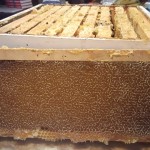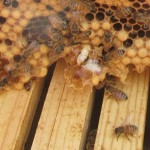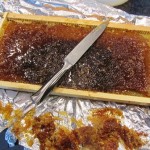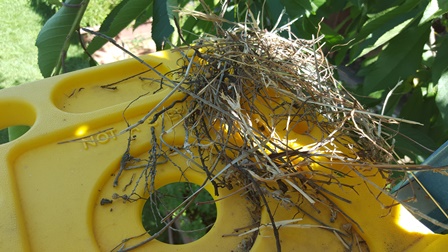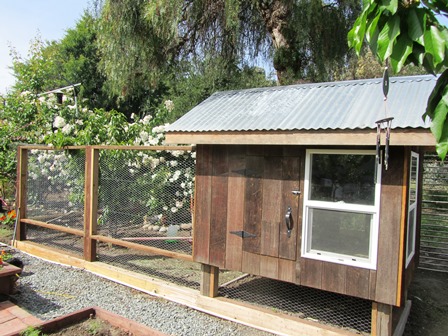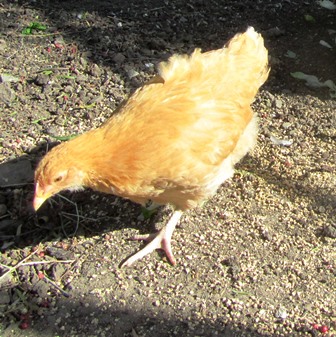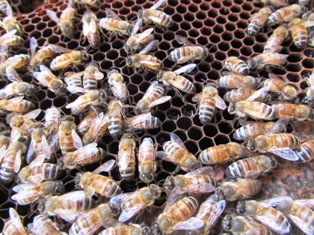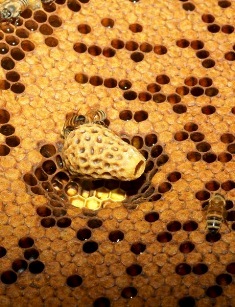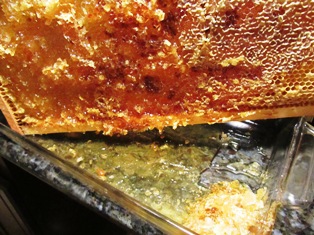Harvesting Honey–Helping Hands Always Welcome
When it comes to opening the hives of honey bees here on our farmette, I’m grateful for the helping hands of my hubby and my neighbor. Carlos, my hubby and helpmate for life, is my go-to guy for all our farm projects. And our neighbor Peter not only has answers to my questions about bees, but also he can open a hive, remove frames of honey, inspect and medicate, and seal the unit lickety-split.
With the smoker at the ready and lit, we opened our hives September 23, 2018. The hives were robust, but the bees appeared stressed. I had added supers to each hive in late July but should have kept a closer eye on the burgeoning bee population. They had become overcrowded and hungry.
For harvesting, we first removed the heavy metal lid of the hive box, replacing it with a fume board. A fume board is a lid lined with fabric that is sprayed with a product that encourages the bees to vacate the supers (some bees immediately leave the box; others go into the brood chambers). The fume board works within seven to ten minutes. We then pulled out the frames of honey, gently brushed off any remaining bees, and took the honey-heavy frames to the kitchen.
For an old hand at beekeeping like my neighbor, the process went quick. Not so for me. This past year, I injured both my shoulders with tears in the rotator cuff tendons. With limitation to some of my range of motion, I’ve felt pretty handicapped. Still, I helped by carrying a single frame of honey at a time from the hive box to the kitchen.
While the hives were open, we removed old medicated strips previously hung in the boxes to thwart mites.
- Small sheets for trapping hive beetles are placed across the frames in the top super before closing the lid
We also replaced the Bee-Gone sheets to trap hive beetles. It’s important to properly handle such items and to keep the apiary clean. We put in medication for mite control–a white gelatinous substance spread on a paper similiar to an index card. Finally, we placed a single patty of bee food on the frames to provide for the bees’ nutritional needs.
The bees immediately coalesced on the patty; no longer stressed, they seemed gentle and calm. Checking the bottom frames, we found a lot of brood (eggs, larvae and pupae of bees). To help this new generation of honey bees along, we inserted an unopened frame of honey that I’d kept wrapped in foil and frozen (freezing kills any insects that could infect the hive or bees). Honey, of course, is the perfect food for them.
We will reopen the hives in two weeks and re-check the status of the bees. A that time, we’ll treat with an antibiotic for winter and possibly add a super if necessary.
I haven’t yet processed the honey we harvested but the frames are on my kitchen counter. They are in a hive box wrapped in aluminum foil. At the ready are also several food-grade buckets that I’ve carefully washed, dried, and covered with lids. The honey spinning machine has been cleaned. Before I begin working with the honey in the frames, I always scrub my kitchen, washing the countertops twice–first with soap and water and then with diluted bleach and hot water.
When everything is clean, I will begin to work on each frame. I first scrape away any bee “glue” from the outside edges of the frame. With a hot knife, I slice all around the interior edges before opening the sealed wax cells (sliding the hot knife just under the wax and lifting). Both sides of the frame are dealt with in this manner. After the wax cells are uncapped, the frame will be placed into the spinning machine. It uses centrifugal force to spin off the honey. The sweet stuff then drains through the strainer material taped around the bucket mouth. The bucket is positioned under the machine spigot.
My reward for this labor of love is having an abundance of sweet, amber honey when desired to bake a honey cake or other culinary creation, to enjoy a relaxing cup of tea, or to fill jars for holiday gift-giving. Beekeeping draws people together and, take it from me, a helping hand is always appreciated.
_______________________________________________________________________________
If you enjoy reading about keeping bees and chickens, growing heirloom vegetables and fruits, or living the farmette (small farm) life, check out my offering of books that tie into themes of living well and close to the Earth.
Grab one or more of my cozy mysteries (no gratuitous sex, profanity, or violence) and discover delicious farm recipes, gardening advice, and tips for caring for bees and chickens.
Or pick up one of my wellness, spirituality, or manifesting books. They make great holiday gifts for yourself and others.
All my books are available in traditional bookstores everywhere and also online at Amazon.com, Barnes & Noble (barnesandnoble.com), Kobo Books, Walmart, and other retailers.
For more information, click on the following URLs:
A HIVE OF HOMICIDES
MURDER OF A QUEEN BEE
A BEELINE TO MURDER

More than 150 rituals for sound mind, strong body, and meaningful connections to the people around you
https://www.amazon.com/dp/B0719HHVRJ/ref=dp-kindle-redirect?_encoding=UTF8&btkr=1
A Sprained Leg Can Spell the End for a Chicken
Foxes have been routinely prowling my property and have claimed two chickens from my neighbor over the last few weeks. Thank goodness, they weren’t my hens. That said, one of my White Leghorns, a breed that originated in Tuscany but is widely raised here, developed a sprained leg, making her extra vulnerable to predators.
I noticed she was having trouble standing a few days ago. Then yesterday, I found her cowering under the hen house steps because the flock had been attacking her. I immediately removed her and tried to find a solution that would allow her time to heal without simultaneously having to find off foes.
My poultry run has its fencing wire buried into the ground and pieces wired together over the top. It’s built that way to prevent entry by raccoons, coyotes, and foxes that dig as well as hawks that hunt from the sky. But what to do with a flock of chickens that will peck to death another hen that get sick or injured?
Yesterday, inside the secure run, I built an inner circular area using poultry wire. Locating a large cardboard box, I filled it with nesting straw and stapled part of an old sheet as a curtain over the doorway. Then I put heavy blankets on the box for warmth (it’s been getting cold at night). I put a water dispenser and food outside her box and hoped for the best.
When I checked on the hen this morning, she was standing upright on both legs. She explored the inner run and then hopped back into the box to wait perhaps for the sun to warm the run. As quickly as she is healing, I might be able to integrate her back into the flock in a few days or a week.
The rains are coming tomorrow–another threat for the poor creature–so I’ll have to figure out another option to keep her dry and warm and safe. Still, she seems to be on the road to recovery and I hope returning to her scratching and foraging soon because she has stopped laying during this traumatic period. And she was one of my best egg layers; she’d lay an extra-large egg almost every other day. See, https://en.wikipedia.org/wiki/Leghorn_chicken
* * *
If you enjoy reading about farm topics (including gardening, beekeeping, and delicious recipes), check out my cozy mysteries A BEELINE TO MURDER and also THE MURDER OF A QUEEN BEE in the Henny Penny Farmette series (from Kensington Publishing).
These novels are available through online retailers such as Amazon, Barnes & Noble, Kobo Books, and Walmart as well as from traditional bookstores everywhere.
Find more info or to order, see, http://tinyurl.com/hxy3s8q
Now available in mass market paperback, this debut novel launched the Henny Penny Farmette series of mysteries and sold out its first press run.
See, http://tinyurl.com/h4kou4g
The Murder of a Queen Bee is the newest offering in the Henny Penny Farmette series. For more information, click on the link under the image.
Summer Salad with a Mediterranean Flair
Inspired by a salad made of lentilles du Puy that I recently ate at a Mediterranean restaurant, I decided to create my own version of it.
The salad combines tiny greenish/brown French lentils with seasonal fresh produce such as heirloom tomatoes and zucchini . I added a chopped onion (sauteed) and some hard-boiled eggs. Dried mint, crumbled fine, along with a little salt and pepper is the only seasoning you’ll need.
This salad is delicious served warm. But it is equally tasty served chilled on very hot days.
French Lentil, Zucchini, and Tomato Salad
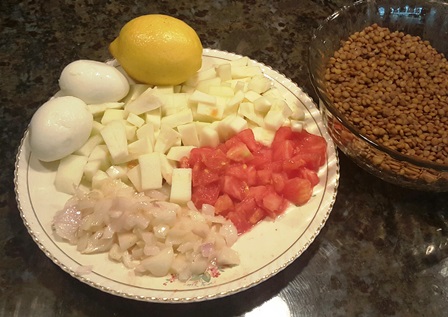
Ingredients for lentil salad include sauteed onions, heirloom tomato, zucchini, hard-boiled eggs, and fresh lemon juice
INGREDIENTS:
1 cup cooked French lentils (the small green or brown variety)
1/2 cup cooked Basmati rice
1 small firm tomato, skinned and chopped
1 cup peeled and chopped fresh zucchini
1 medium red or yellow onion, coarsely chopped and lightly sauteed
2 hard-boiled egg, chopped
1/4 c dried mint, crumbled fine by rubbing between your palms
1/2 medium juicy lemon
salt to taste
DIRECTIONS:
Combine the cooked lentils and rice. Add the zucchini, tomato, sauteed onion, and chopped hard-boiled egg to the lentil-rice mixture. Crumble the dried mint over the salad. Season with salt and pepper. Squeeze the juice from 1/2 lemon over the mixture and combine well before serving. Serves 4-6.
*Try pairing this salad with a rosemary chicken or lamb wrap for a light lunch.
* * *
If you enjoy reading about farmette topics (including gardening, beekeeping, and delicious recipes), check out my cozy mysteries A BEELINE TO MURDER and also THE MURDER OF A QUEEN BEE in the Henny Penny Farmette series (from Kensington Publishing).
These novels are available through online retailers such as Amazon, Barnes & Noble, Kobo Books, and Walmart as well as from traditional bookstores everywhere.
Now available in mass market paperback, this debut novel launched the Henny Penny Farmette series of mysteries and sold out its first press run.
The second cozy mystery in the Henny Penny Farmette series, available Sept. 29, 2016
Sleuthing Egg Loss and a Nest’s Destruction
What a difference twelve hours makes. When we retired last night, the mourning doves were on their nest atop our tall ladder next to the cherry trees. It was day twelve since the birds built the nest in our garden, so we expected to see babies hatching any day now. Alas, this morning the dove family had fled and there was no sign of eggs or babies.
I believe something raided the nest. It should come as no surprise. Building it on that site seemed like a foolhardy proposition from the start. And to position it on the shelf of the ladder, exposed and near a hole big enough for a chicken egg to fall through seemed a little ridiculous.
And yet, the dove pair dutifully took turns incubating the eggs, even when the mercury hovered at the hundred degree mark on the outdoor thermometer.
In the spirit of helping the family, I kept the fountains filled with fresh water and threw handfuls of birdseed along the stone retaining wall so the pair would have a ready supply of food. Each morning, I’d hurry out to check on the doves before tackling more chores.
When I noticed the nest today and realized it was empty, the eggs were gone, and there was no sight of the doves, I began sleuthing. On the ground near the ladder lay a single long black feather and lots of leaves, knocked from the cherry trees. Not many clues but enough to make a supposition.
I recall that a flock of crows flew in to roost in nearby trees just before dusk last night. They’re both smart and predatory. They’ll raid other nests and eat eggs. I surmised that either they or a local cat or racoon drove away the dove pair and laid waste to the eggs. And yet as I write this, I can see beyond my garden window that a pair of doves are eating the seeds I cast upon the stone wall. Mourning doves can build a nest and lay a set of eggs six times during spring, so there’s still hope.
* * *
If you enjoy reading about wildlife and other topics (including delicious recipes and gardening tips) related to farmette living, check out my cozy mysteries from Kensington Publishing. The first two in the Henny Penny Farmette series are available online at Amazon, Barnes and Noble, Walmart, KOBO Books, and other sites as well as in traditional bookstores everywhere.
BEELINE TO MURDER, see http://tinyurl.com/jo4cxy
MURDER OF A QUEEN BEE, see http://tinyurl.com/zu8s7pf
Buffo’s Gone Broody
My Buff Orpington hen won’t leave the nest. I’ve taken to putting out a bowl of crumbles and a canister of water so she’ll have nourishment while she sits on a a pile of eggs.
I’m beginning to think that with her this broody period is going to happen about every six months–at least that’s been the case so far.
Ruby the Rhode Island Red, the Wyandotte sisters, the Black Sex Link, and my two white leghorns are being de-laned into the two other boxes. And I have to practically crawl into the chicken house to reach the last nest box to retrieve their eggs.
Our town doesn’t permit us to keep roosters. Ergo, those eggs that Buffo is trying to hatch will have to be tossed at the end of her broody period. They’re not fertile and will never hatch. But I haven’t the heart to tell her.
* * *
If you enjoy reading about farmette life, check out my cozy mystery novel series from Kensington Publishing, New York. The books feature a farmette milieu, farm sayings, tips, and facts as well as delicious recipes to try. The books are available from online sources such as Amazon, Barnes & Noble, Walmart and others as well as traditional bookstores everywhere.
Blankets for Trees & Bees on Frosty Nights
I don’t like to take chances with my citrus trees when overnight temperatures drop to near freezing. I cover them with sheets and blankets.
My hives are in a wooden shelter with a tin roof and the back side open, so I can work without any encumbrance. But I don’t want the bees to have to work harder to keep the hive warm for the queen and babies, so I throw some blankets over my beehives, too.
Also, on particularly cold nights, I hang a warming lamp in my chicken house. My rule of thumb for my hens is when overnight temperatures are expected to drop below 45 degrees, I turn on the lamp so the hens aren’t stressed.
An advantage of hanging a heat lamp in the chicken house is to foster egg laying at time when shorter days of light slows egg production. The heat lamp makes light available to the chickens for a much longer period.
Why We Should Love Toads
What is brown, relatively smooth-skinned, and burrows into dry soil in Western gardens? The answer is the Western spadefoot toad, and there are plenty of reasons to invite them them into making their home near yours.
They like to dine on cutworms, flies, grasshoppers, slugs, grubs, wood lice, and other small insects. In fact, a single spadefoot toad will eat roughly 10,000 to 20,000 insects a year. And that’s just from spring until fall, when they go into hibernation.
After eating all those insects, you’d think they might head for your vegetable patch or flowers. But no, they aren’t interested in harming your herbs, flowers, or veggies.
We can help these toads set up housing in our gardens by creating a shallow impression in the soil and placing a board or two over it, leaving just enough room for the toad to hop in. For an image and to hear the sound of the spadefoot toad, see: http://www.californiaherps.com/frogs/pages/s.hammondii.html
Like most living creatures, they need water. A water garden, pond, or even a ground-level plant saucer or bird bath will do the trick. An added benefit of a water garden or small pond is its attractiveness to toads to lay their eggs, ensuring generations of toads in your garden for years to come.
Update on the Buffo Broodzilla
My Buff Orpington hen, who’d been sitting on a couple dozen infertile eggs for weeks–some rotten and others broken–finally left the nesting box after I removed all the eggs. I’ll be set up for baby chicks next year in my hen house, but not now.
At first, she continued to display her broodzilla behaviors (aggressive, flighty, angry) and was easily set off by the antics of the other chickens. However, within a day or two, she’d normalized her old laying routine and began running with the other hens as they foraged around the farmette, took dust baths, clamored for chicken snacks, and pecked at each other.
My neighbor told me to dunk her in cold water to break her broody cycle. That’s because hens who go broody have an elevated body temp. Removing the eggs worked this time; maybe next time, I’ll try cooling her off. Or . . . if it happens in the spring, I might get some baby chicks and let her raise them.
I’m certain there will be a next time–she’s gone broody three times in a year and half. Some hens have that tendency.
Time to Open the Hives, Check on the Bees
My honeybees have become surprisingly active for the dead of winter. Local forecasters tell us that the Bay Area temperatures may reach 80 degrees Fahrenheit by the end of the week. My apple and early peaches won’t wait; they’ve already blossomed.
The warm weather, time of year together with the fact that almond trees will be blooming in a couple of weeks and the lavender around my farmette is already blooming tells me I have to open the hives. My beekeeper neighbor says that his bees are already out collecting pollen–lots of it–and that means we have to get to work.
The hives have to be checked now for mold (that long period of hard rain in December caused some of my neighbor’s frames to mold). Moldy frames can’t be renewed; they have to be tossed. Honeybees can get nosema (with diarrhea), which shows up as spots at the base of the hive.
The bees are finding flowers on their forage runs and are returning to the hive laden with pollen.
Bee queens will be busy laying eggs in the coming weeks, if they aren’t already. This is the time for beekeepers to purchase new queens. By the first week in April, it’s possible we could see swarming.
So here’s the plan. If the hives have a lot of honey, I’ll harvest some. Strange to be doing that in winter, but the hive will need space for brood. I’ll have to remove frames of honey and insert empty frames with wax (put in the freezer first for a period to kill any pest they might be harboring over).
I’ll put bee food patties in the open hives, so they’ll have plenty to eat (once I take some of their honey). My beekeeper neighbor tells me this will get the hive “heated up” for the queen to do what she does best–lay the eggs.
With so much activity, I’m confident that everything will turn out well, but you never know until you’ve inspected the interior of the hive and checked out everything, including the possibility of mold or the presence of pests or illness.
Mother Nature didn’t ask me, but I would have preferred she wait another month before removing her winter robes and dressing in spring florals. It just seems like now everything to do with the hives is on fast forward!
Try Having a Cup of Tea with These Dogs
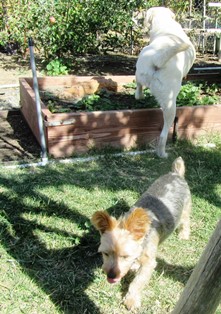
Remington, the white, short-haired lab, is trouncing over the strawberries, while Moose has his sights set on the chickens
I just wanted a nice cup of tea and to sit on the grass and sip it while listening to the birds and watching my bees and chickens. Fat chance. It would take five minutes flat for my daughter’s little dog Moose to knock over the cup, spill the tea all over me, and then traumatize my chickens so badly that their egg-laying is now out of wack; they’re just squatting and dropping.
As a favor to my lovely daughter and her family, I agreed to dog sit on my farmette for four days. My daughter assured me the two family pets would enjoy four days of freedom to romp around our acreage despite one of her dogs being a little high strung. His breed used to chase rats, she said. I didn’t make the correlation. It didn’t seem to matter then.
I reminded her that my bees and chickens both forage freely over the land. The chickens would necessarily have to remain in their chicken run during that period since the dogs might chase them. The bees probably wouldn’t bother the dogs, but I’d take the name of her vet, just in case. Of course, the dogs might not actually like it here.
In retrospect, I believe I underestimated my concerns. Oh, the dogs seem happy enough; it’s my sanity I’m worried about.
The Irish lab named Remington has had some professional training. He is a lovely, well-behaved gentleman. I enjoy him and wish I could same the same for the small dog with the mighty name of Moose who is high-strung, has allergies, and arrived with special gluten-free food, his round bed, and a bag of medications, including a vet-prescribed tranquilizer.
Moose barks a lot. It’s an annoying high-pitched bark. In the yard yesterday, when he wouldn’t stop, I heard my neighbor barking back . . . and that’s just ridiculous!
I thought Moose was going to have a meltdown when he discovered the chickens, barking at the highest decibel he could muster, running the length of the chicken run in one direction with the chickens one step ahead on the inside their poultry-wire pen before hitting the wall where the dog and chickens reversed their direction.
I got half as many eggs yesterday and found two on the ground instead of in the nesting boxes. When the chickens free-range, they always return to the nesting boxes in the hen house to lay their eggs. It’s like they got so scared, they forgot not only where to go but how to properly lay their eggs. I hope things return to normal when the dog visit is over.
I decided to spend the day outside, doing chores like digging planting holes at the front of the property. Moose saw it as a game so as soon as my back was turned, he refilled the holes, pawing like a dog on a mission. I finally gave up on that. The shovel and rake seemed to scare him, so I put those away. And he didn’t like me playing ball with him or the other dog. So we quit on that, too.
By the day’s end though, both dogs seemed tuckered out. Both wanted to sleep in our room. The big dog contented himself in his bed on the floor (by my husband’s side of the bed), but the high-maintenance Moose threw himself onto my pillow, pulled my fleece bathrobe over his head, and nodded off like he owned the place.
When our alarm went off at four o’clock as it does every weekday morning, the yip-yip-yipping and chaos started all over again. Only three more long days and nights left.
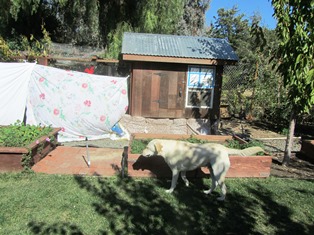
Remi wasn’t the problem but with Moose frightening the chicken feathers off my hens, I draped the chicken run in sheets
I’m going to need a vacation when these four days are over. I just hope my chickens will resume their egg-laying schedule once I take the sheets down off the chicken run (I hung them so Moose couldn’t see the chickens) and I have the energy and some decent weather ahead to re-dig those planting holes. I look forward to having a cup of tea again, too, while I listen to the birds and quiet clucks instead of that shrill yip-yip-yip, amplified by by neighbor’s imitation of it. Ridiculous!
 Facebook
Facebook Goodreads
Goodreads LinkedIn
LinkedIn Meera Lester
Meera Lester Twitter
Twitter





